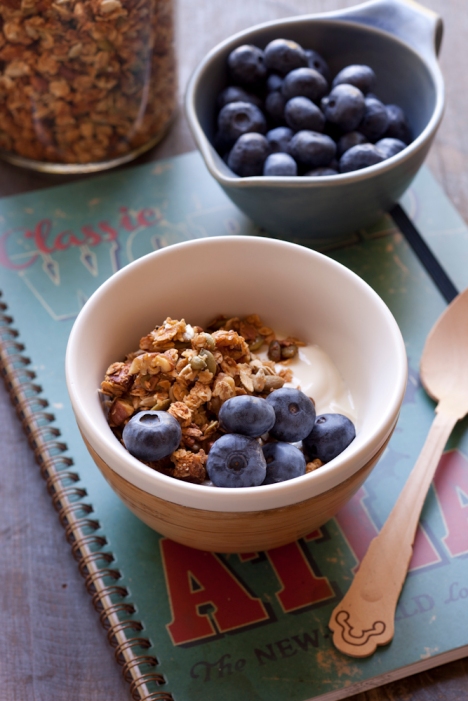As the summer holidays draw to a close, back to school preparations are well underway. It’s no secret that good study habits lead to success, but what many students don’t realise is that it is essential to eat well in order to provide A-grade fuel for your brain.
Here are some ‘brain foods’ to help you –and yes, there will be chocolate!
Kickstart your energy levels and improve your concentration by beginning the day with wholegrains. Berries are another fabulous ‘brain food’, containing compounds that boost brain signals and help memory. Calcium rich foods, such as yoghurt, improve nerve function – combine with berries and wholegrains or blended into a super smoothie for a breakfast brain boost!
Good nutrition should also be a vital component of your study plan. During study breaks, it is important to eat foods that will boost energy and concentration levels, as too many processed carbohydrates can leave you feeling sleepy. Instead of biscuits, munch on fresh fruit or raw vegetable sticks, nuts and seeds. Nuts and seeds contain proteins, vitamins and essential fatty acids. Walnuts, almonds, pecans and cashews are top of the list and make a great snack at home, but be careful, as most schools have nut free policies due to the health and safety hazards they pose to students with extreme allergic reactions. Including Sunflower seeds and pumpkin seeds in homemade granola or sprinkled over a healthy lunchtime salad can boost brainpower too.
Eggs, avocadoes and tomatoes are all good for brain health, so why not put them all together in a super salad to help you power through the day?
Of course, it’s no surprise that broccoli and spinach are superfoods, so be sure to enjoy these often, along with lots of other vegetables as part of a healthy diet. Possibly one of the best brain foods around is Fish. Combine it with leafy greens for a fast and easy mid week dinner.
And yes, chocolate really is good for your brain. Dark chocolate has antioxidants and natural stimulants that improve focus and concentration. However, this is the one superfood that you should have in moderation.
Improve your performance at school this year by eating smarter…it’s a no brainer!
granola with yoghurt and blueberries
A healthy breakfast, full of super brain food, to kick-start the day. If you can’t eat nuts, simply replace them with extra oats or reduce the amount of honey.
2 cups rolled oats
1 cup mixed nuts (optional), roughly chopped
half cup of pumpkin seeds
half cup of sunflower seeds
quarter cup linseed
three quarters of a cup honey, warmed
500ml plain yoghurt
2 punnets blueberries
Preheat oven to 180C.
Mix oats, nuts and seeds in a medium bowl, add honey and stir to combine.
Spread out mixture on a lined oven tray. Bake for 30 minutes until golden and crunchy, stirring halfway through. Remove from oven and cool. Break up into chunks and store in airtight container until ready to use.
Serve with a dollop of yoghurt and fresh blueberries.
Serves 4.
Super school salad with tuna, egg, tomato, avocado and spinach
Make your own tamari seed mix by combining pumpkin, sunflower, sesame and linseed with tamari soy sauce and a little sesame oil. Bake in a moderate oven for 10-15 minutes, stirring, until browned.
1 hardboiled egg
95g small tin tuna on oil
handful cherry tomatoes, cut in half
quarter avocado, sliced
handful baby spinach leaves
¼ cup tamari seed mix
¼ cup mixed sprouts
½ lemon, to squeeze
Put everything into a lunch box and mix together at school. Squeeze over the lemon juice and toss together before serving.
Serves 1.
tip: to hard boil eggs, place eggs in a small saucepan and cover with water. Bring to the boil, reduce heat and simmer gently for 6-8 minutes for extra large eggs. Drain and run under cold water to cool eggs down quickly.
teriyaki salmon with shiitake mushrooms
Look out for New Zealand salmon, which reportedly has double the amount of omega-3. It has a stronger flavour, but this is balanced by the marinade.
I use shiitake mushrooms, but any small mushroom will suffice.
4 salmon fillets (about 150g each)
¼ (quarter) cup mirin + ¼ (quarter) cup extra
½ (half) cup salt reduced soy sauce + ¼ (quarter) cup extra
fresh lime, to juice
1 punnet fresh shiitake mushrooms
2 tsp caster sugar (optional)
steamed vegetables to serve
cooked brown rice to serve
Cut each salmon into 3 bite size pieces.
Place mirin and soy in a large shallow bowl with the salmon and set aside in the fridge to marinate for 5-10 minutes.
Slice the mushrooms thinly, then place in a small saucepan with extra ¼ cup mirin and soy. Add sugar to taste and cook over medium low heat for 5 minutes until the mushrooms are softened and the sauce is slightly reduced. Set aside.
Heat oven grill to high. Place salmon pieces on a foil lined oven tray and place under grill for a few minutes until the top of the salmon becomes opaque. Turn pieces to cook the other side.
Remove from grill and serve with mushrooms, brown rice and steamed vegetables.
Serves 4.
Tip: to cook brown rice, firstly soak in cold water for 30 minutes. Then place drained rice in saucepan. For one cup of rice, use approximately one and a half cups of water. Bring to the boil, reduce heat, place a folded teatowel over the top of the pan and cover tightly with the lid. Cook over low heat for around 35 minutes.
Filed under: Uncategorized | Tagged: brain foods, essential fatty acids, good study habits, homemade granola, pumpkin seeds | Leave a comment »














